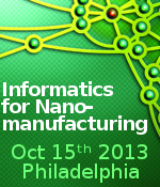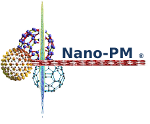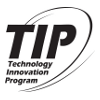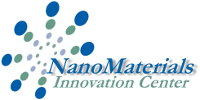2013 Program
| Tuesday, October 15, 2013 | |||
| 8:00-4:30 | Informatics for Nanomanufacturing Workshop Agenda Workshop Chairs: |
||
| Wednesday, October 16, 2013 | |||
| 7:45 | Registration Opens Continental Breakfast served in the Showcase/Poster Session Area |
||
| 8:30-9:00 | Opening Remarks Dr. Jeffrey Morse, Managing Director, National Nanomanufacturing Network Vincent Caprio, Executive Director, NanoBusiness Commercialization Association |
||
| 9:00-9:30 | Keynote: Dr. Rutledge Ellis-Behnke, Ph.D., Research Affiliate, Brain & Cognitive Sciences, MIT/Prof, University of Heidelberg/Director, Nanomedicine Translational Think Tank | ||
| 9:30-10:00 | Keynote: Dr. Anita Goel, MD, Ph.D., Chairman & CEO, Nanobiosym | ||
| 10:00-10:30 | Keynote: HzO Case Study of Growth Jim Phillips, Chairman/CEO, NanoMech Inc. | ||
| 10:30-11:30 | How Can Nanotech Companies Build Long-Term Patent Portfolios That Will Protect Investors & Cover Future Product Designs?
The Supreme Court has been subjecting US patents to heightened scrutiny in cases like Myriad, where it struck down a claim covering a “product of nature.” Another round of legislative changes to US patent law has further complicated patent planning for companies. Against a backdrop of heightened judicial scrutiny and changing laws, nanotech companies need to build long-term patent portfolios that protect investors, yet are flexible enough to protect future product designs or even completely different application areas than those envisioned by company founders. The long product development cycles for nanotech make it especially hard to build a patent portfolio that will satisfy these objectives. Panelists will provide insights into how nano innovators can meet these challenges and profit from opportunities created by the changing US patent environment. Among other topics, panelists will discuss:
Moderator: Steve Maebius, Partner, Foley & Lardner LLP |
||
| 11:30-12:30 | State of the Union - Nanotechnology Environmental Health Safety (EHS) 2014
Lynn L. Bergeson, Managing Director, Bergeson & Campbell, P.C. |
||
| 12:30-1:15 | Lunch | ||
| 1:15-2:00 | Keynote Panel: NNI - 10 Year Retrospective/Look Forward
Dr. Jeffrey Morse, Managing Director, National Nanomanufacturing Network |
||
| Nanomanufacturing | Nanomedicine/Research Centers - The Role of Innovation | ||
| 2:00-2:30 | Paul S. Clayson, President & CEO, HzO, Inc. | 2:00-3:00 | The Multistage Nanovector Delivery System: From Bench to...almost Clinic Jason H. Sakamoto, Ph.D., Co-Chair, Assistant Member, Department of Nanomedicine, Houston Methodist Research Institute A Revolution in the Treatment of Metastatic Cancer |
| 2:30-3:00 | Carbon Nanotubes Manufacturing & Applications David J. Arthur, CEO, SouthWest NanoTechnologies Inc. |
||
| 3:00-3:30 | Joe Piché, CEO, Eikos | 3:00-4:00 | From Technology Push to Market Pull: The Role of Research Centers in the Nanotechnology Innovation Ecosystem
Cluster university R&D investments into a research center around a specific science or engineering opportunity and a vibrant innovation economy will result, right? Not likely. Most NSF, NIH or even state-funded university research centers do not maximize their regional economic outcome potential. Well-designed research centers, though, can help bring an innovation ecosystem together through increased attracted R&D funding, the spillover effects of knowledge dissemination, student learning experiences, local early access to new technologies, and, yes, even more successful companies and local job creation. In this practitioner-focused session, we’ll examine innovative research centers taking more holistic approaches to help bring innovation ecosystems together – and the lessons they’ve learned on what works and what doesn’t. Presenters: From (nano)Technology Push to Market Pull: the ONAMI Model Utilizing the Oregon Startup Ecosystem |
| 3:30-4:00 | pixelligent - The Clear Solution Dan Russell, Senior Vice President, Manufacturing & Operations, Pixelligent Technologies, LLC |
||
| 4:00-4:30 | Scott Jacobs, Vice President Product Development, Treasurer & Director, Quantum Confined | 4:00-4:30 | Nano Patents for Cash Flow and Stock Price, and Financing for Nano Patent Monetization and Enforcement Stephen C. Glazier, Partner, K&L Gates LLP |
| 4:30-5:00 | Keynote: Ram Trichur, Carbon Electronics Business Development Manager, Brewer Science | ||
| 5:00-5:30 | Keynote: Scott Livingston, Chairman & CEO, Livingston Securities | ||
| 5:30-7:30 |
Reception Greeting: Mark G. Allen, Ph.D., Scientific Director, Krishna Singh Center for Nanotechnology, Professor, Department of Electrical & Systems Engineering, School of Engineering & Applied Sciences, University of Pennsylvania |
||
| Thursday, October 17, 2013 | |||
| 7:45 | Registration Opens Continental Breakfast served in the Showcase/Poster Session Area |
||
| 8:25 | Opening Remarks Vincent Caprio, Executive Director, NanoBusiness Commercialization Association Dr. Jeffrey Morse, Managing Director, National Nanomanufacturing Network |
||
| 8:30-9:00 | Keynote: Dr. Larry Hough, Lab Manager: Complex Assemblies of Soft Matter Laboratory (COMPASS UMI 3254), Corporate Research & Innovation, Solvay | ||
| 9:00-9:30 | Keynote: Inframat Corporation
David E. Reisner, Ph.D., Founder, Director, International Sales Leader, The Nano Group, Inc. |
||
| 9:30-10:00 | Keynote: An Overview of Some of the More Interesting Nanotechnology Inventions – One Patent Attorney’s Perspective
Jeffrey H. Rosedale, Partner, Woodcock Washburn LLP |
||
| Graphene Development & Commercialization | Nanotechnology and the Law | ||
| Sponsored by Graphene: The Next Wonder Material? |
10:00-11:00 | Product Stewardship for Nanotechnology Products: Current Regulations and Risk Management Proactive approaches to product stewardship help successfully place products of nanotechnology into commercial markets. Understanding the regulatory frameworks that govern the end use of the product(s) is critical to successful commercialization. We review recent and emerging regulations in the US and Europe that govern the use of nanotechnology products. Even in the absence of existing regulations, a proactive approach requires a science-based evaluation of whether existing risk management is adequate or requires additional measures to address uncertainties from data or knowledge gaps. Risk Management and Minimizing Legal Exposure Product Stewardship for Nanotechnology Products: Current Regulations and Risk Management |
|
| 10:00-11:00 | Session 1: Developing Graphene: Standards, Tools, Nomenclature
Moderator: Dr Alan Rae, Co-founder, Graphene Stakeholders Association Graphene Measurement and Standards Metrology Solutions for 2-D Nanomaterials Dr. Angela Hight Walker, Senior Scientist, NIST |
||
| 11:00-12:00 |
Session 2: Graphene Production: Recipes for Success
Moderator: Keith Blakely, Co-founder, Graphene Stakeholders Association Graphene and Beyond: Recent Progress in the Production of 2D Materials Commercialisation of Graphenes John Biondi, CEO, Xolve Inc. |
11:00-12:00 | Nanotechnology and OEHS Harmonization; A Global Approach
Materials Science has been integral to the advancement of mankind since time immemorial. Because of the many advances these technologies have introduced, we’re generally accustomed to an ever-increasing continuum of change while also accepting the inherent risks that occur. With nanotechnology, however, society has taken a somewhat tempered approach to this progress and balanced benefit against a notably more cautious approach. This is evidenced by the National Nanotechnology Initiative which mandates that Occupational, Environmental, Health and Safety (OEHS) be as critical a component to the science of nanotechnology as the materials sciences in which it exists. The presentation offered here will provide participants with a global overview of current good practices associated with Nanotechnology OEHS and detail those programs under development to minimize and control these unique risks. Donald Ewert, IH, VP-Field Services, nanoTox, Inc. |
| 12:00-1:00 | Session 3: Graphene Roadmap - Innovation and Commercialization Prospects
Moderator: Stephen Waite, Co-founder, Graphene Stakeholders Association Graphene Frontiers High Performance Products Powered by Graphene | ||
| 1:00-1:45 | Lunch | ||
| 1:45-2:00 | The NCMS-NSF Survey of Nanotechnology in US Manufacturing Industry Manish Mehta, Ph.D., Director, Principal Investigator - 2013 NCMS-NSF Nanotechnology Commercialization Readiness Study, National Center for Manufacturing Sciences (NCMS) |
||
| Nanobiotechnology Commercialization | |||
| Nanobiotechnology Commercialization Moderator: Anthony P. Green, Vice President, Technology Commercialization Group - Life Sciences and Ben Franklin Director, The Nanotechnology Institute & Energy Commercialization Institute |
|||
| 2:00-2:30 | Nanobiotechnology for Tissue Engineering and Regenerative Medicine Peter I. Lelkes, Temple University & Eqalix LLC |
||
| 2:30-3:00 | Acoustic tweezers: manipulating particles, cells, and organisms using standing surface acoustic waves (SSAW)
The ability to manipulate cells and microparticles in a biocompatible and dexterous manner is critical for numerous biological studies and applications such as cell-cell communication, biosensing, tissue engineering, and regenerative medicine. Here we summarize our recent progress on an “acoustic tweezers” technique that utilizes standing surface acoustic wave (SSAW) to manipulate particles, cells, and organisms. This technique is capable of manipulating cells and microparticles regardless of shape, size, charge or polarity. Its power intensity, approximately 107 times lower than that of optical tweezers, compares favorably with those of other active patterning methods. Cell viability, proliferation, and apoptosis studies have revealed the technique to be biocompatible. The aforementioned advantages, along with this technique’s simple design and ability to be miniaturized, render the “acoustic tweezers” technique a promising tool for various applications in biology, chemistry, engineering, and materials science. Prof. Tony Jun Huang, CTO, Ascent Bio-Nanotechnologies, Inc. |
||
| 3:00-3:30 | Bernardo Cordovez, President, Optofluidics, Inc. | ||
| 3:30-4:15 | FBI Counterintelligence Strategic Partnership | ||
| 4:15-5:00 | Overview Griffith A. Kundahl, Vice President, Business Development & Government Relations, Nano Risk Assessment, Inc. Vincent Caprio, Executive Director, NanoBCA |
||







































